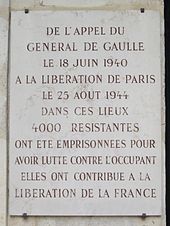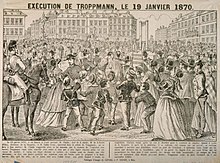La Roquette prisons
The prisons of La Roquette were two penal institutions in the Parisian Quartier de La Roquette in the 11th arrondissement , on either side of the Rue de la Roquette . The older one existed from 1830 to 1974, the younger from 1836 to 1900. Today, the Park Square de la Roquette is located on the site of the first prison .
history
The creation of the prisons
In 1826, under the reign of Charles X , it was decided to build a youth prison in Paris. A site near the Père Lachaise cemetery , at 143 rue de la Roquette, was chosen as the building site . A convent that had been closed during the French Revolution had previously been located there. The architect was Louis-Hippolyte Lebas , who also built the Notre-Dame-de-Lorette church. The design was based on the model of the Panopticon by the British philosopher Jeremy Bentham . The hexagonal building opened on September 11, 1830 and was called La Roquette by the Parisians . (Location)
In the same year, King Louis-Philippe I , worried by an increase in the number of prisoners in Paris, decided to build another prison, although there were already around twelve. The Cologne- born architect François-Chrétien Gau presented the plan for a square building with an inner courtyard, which was surrounded by a ring-shaped wall. This new building was created opposite the existing one (location) . During the construction of this second prison there were protests against executions at this site. As a result, the guillotine was relocated to Place de Gréve , five kilometers away , in 1832 , south of today 's Saint Jacques metro station .
The second prison went into operation on December 24, 1836 and initially 187 prisoners were transferred there from Bicêtre prison . The official name of this new prison was Dépôt de condamnés , because prisoners were housed here before their deportation to the penal colonies of Île de Ré , Cayenne and New Caledonia . There were also people sentenced to death here. The Parisians soon made a distinction between the two prisons in Petite Roquette (the first prison) and Grande Roquette .
The guillotine in the Grande Roquette
On November 29, 1851, a new place for executions was established in Paris by decree . The guillotine was set up at the entrance to the Grande Roquette : For this purpose, special plates were attached to the pavement at five points to set up the apparatus; these places can still be seen today. The first execution took place just three weeks later. A total of 69 prisoners were executed with this guillotine by 1899. One of them was the eightfold murderer Jean-Baptiste Troppmann in 1870 . In 1871, during the Paris Commune, six hostages were shot dead by the rebels in the Grande Roquette for the release of Communards , including the Archbishop of Paris, Georges Darboy , other clergymen and a judge.
In the course of the 1890s there was a growing number of public voices criticizing the conditions in the prison. The French President Félix Faure then closed the Grande Roquette and moved the prisoners to La Santé . In 1900 the prison was demolished and houses were built in its place.
The Petite Roquette
The Petite Roquette prison, on the other hand, remained in operation, albeit under different conditions from the 1920s. The juvenile offenders have been transferred; the Petite Roquette was converted into a women's prison and remained so until it was closed in 1974.
According to a law of 1939 that prohibited the execution of women in public, these - there were ultimately two - were carried out in this prison from then on. One of the two women executed was Marie-Louise Giraud in 1943 , who had been sentenced to death for carrying out abortions . During the occupation, the Petite Roquette was used by the Germans to imprison resistance fighters, including the actress Steffie Spira-Ruschin , the journalist Lenka Reinerová , the unionists Suzanne Masson and Cläre Quast, and Dora Schaul .
After its closure, the prison was demolished and the Park Square de la Roquette was built in its place . A former porter's house of the prison serves as the entrance.
literature
- Dominique Leborgne, Danièle Chadych: Vie et histoire du XI. arrondissement . Èd. Hervas 1990, ISBN 978-2-903118-27-3
- Yvette Sémard, Gilles Perrault : En souvenir de l'avenir. Au jour le jour dans les camps de Vichy 1942-1944. La Petite Roquette, les camps des Tourelles, d'Aincourt, de Gaillon, de La Lande et de Mérignac. Ed. L'Arbre verdoyant. Montreuil. 1991. ISBN 978-2-86718-023-1





